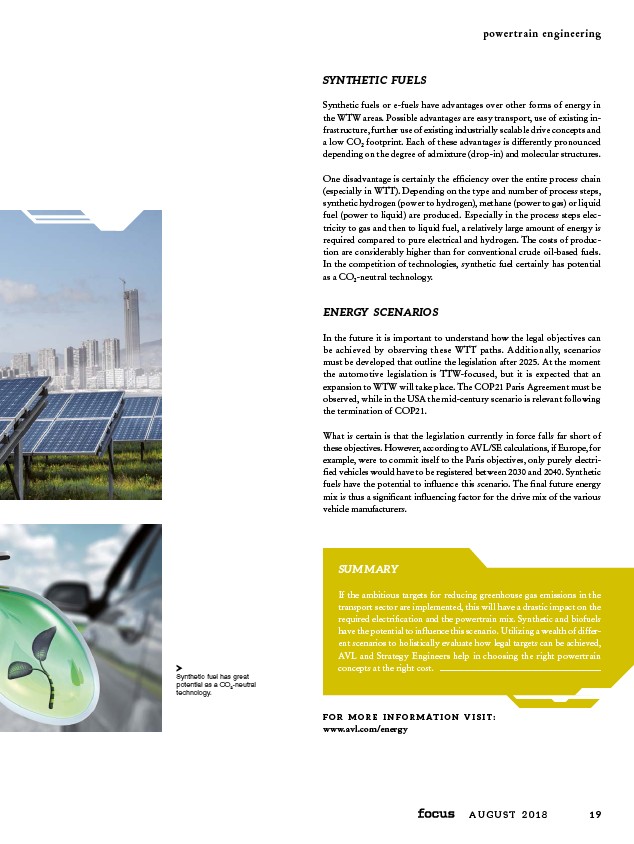
SYNTHETIC FUELS
powertrain engineering
Synthetic fuels or e-fuels have advantages over other forms of energy in
the WTW areas. Possible advantages are easy transport, use of existing infrastructure,
further use of existing industrially scalable drive concepts and
a low CO2 footprint. Each of these advantages is differently pronounced
depending on the degree of admixture (drop-in) and molecular structures.
One disadvantage is certainly the efficiency over the entire process chain
(especially in WTT). Depending on the type and number of process steps,
synthetic hydrogen (power to hydrogen), methane (power to gas) or liquid
fuel (power to liquid) are produced. Especially in the process steps electricity
to gas and then to liquid fuel, a relatively large amount of energy is
required compared to pure electrical and hydrogen. The costs of production
are considerably higher than for conventional crude oil-based fuels.
In the competition of technologies, synthetic fuel certainly has potential
as a CO2-neutral technology.
ENERGY SCENARIOS
In the future it is important to understand how the legal objectives can
be achieved by observing these WTT paths. Additionally, scenarios
must be developed that outline the legislation after 2025. At the moment
the automotive
legislation is TTW-focused, but it is expected that an
expansion to WTW will take place. The COP21 Paris Agreement must be
observed, while in the USA the mid-century scenario is relevant following
the termination of COP21.
What is certain is that the legislation currently in force falls far short of
these objectives. However, according to AVL/SE calculations, if Europe, for
example, were to commit itself to the Paris objectives, only purely electrified
vehicles would have to be registered between 2030 and 2040. Synthetic
fuels have the potential to influence this scenario. The final future energy
mix is thus a significant influencing factor for the drive mix of the various
vehicle manufacturers.
SUMMARY
If the ambitious targets for reducing greenhouse gas emissions in the
transport sector are implemented, this will have a drastic impact on the
required electrification and the powertrain mix. Synthetic and biofuels
have the potential to influence this scenario. Utilizing a wealth of different
scenarios to holistically evaluate how legal targets can be achieved,
AVL and Strategy Engineers help in choosing the right powertrain
concepts at the right cost.
FOR MORE INFORMAT I O N V I S I T :
www.avl.com/energy
A U G U S T 2 0 1 8 1 9
Synthetic fuel has great
potential as a CO2-neutral
technology.